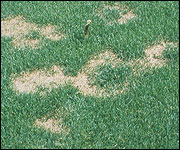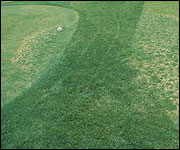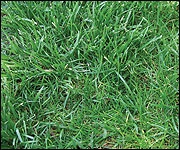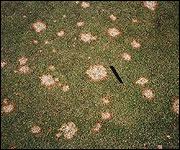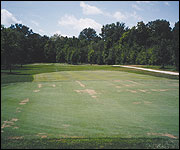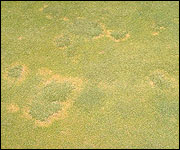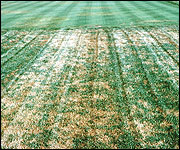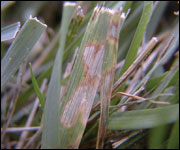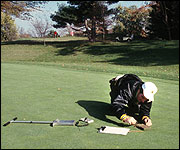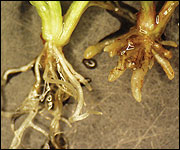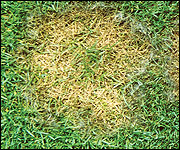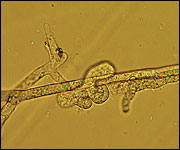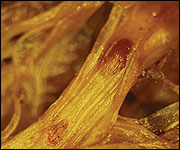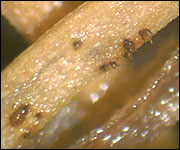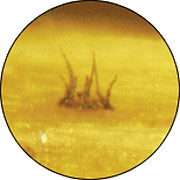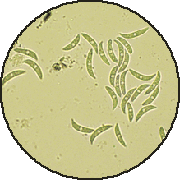Tips for diagnosing turfgrass disease
Accurate diagnosis is the key to managing turfgrass disease in an environmentally and economically sound manner. When the cause is not accurately identified and management practices and control measures are not developed accordingly, inputs are wasted and high reestablishment costs may be incurred.
Recognize that there are two types of pathogens that cause plant disease:
- Infectious or biotic
- Noninfectious or abiotic
Most of the common turfgrass diseases are caused by plant pathogenic fungi. Plant parasitic nematodes can also cause disease in some situations. Keep in mind that insect infestation can also result in damage to turfgrasses.
The following steps can help you learn to diagnose the cause of turfgrass problems:
Identify the host plant
Many infectious diseases of turfgrass are caused by patho-gens that are host specific. For example, summer patch can be a severe problem on Kentucky bluegrass, some fine fescues and Poa annua, but has little or no effect on perennial ryegrass, tall fescue or bentgrass (Figure 1). Another example is large patch, which affects zoysiagrass, bermudagrass and buffalograss, but not cool-season grasses (Figure 2). Sometimes undesirable grasses such as Poa trivialis look diseased to the untrained eye (Figure 3).
Note prevailing environmental conditions before and during disease outbreak
Many turfgrass pathogens develop within a fairly narrow range of temperature and moisture. Learning the environmental conditions that favor infection and disease development will help in disease diagnosis and assist in the timing of cultural management inputs and preventive fungicide applications.
The environment also includes such factors as location in relation to air movement and amount of sunshine, physical characteristics of the root zone and depth of thatch.
Observe the on-site pattern of damage
The pattern associated with infectious disease often appears random (Figure 4). Infectious disease is often limited to a single species in the stand. In contrast, disease caused by abiotic factors often affects multiple species. The pattern of damage caused by an abiotic pathogen may be uniform or coincide with a recent cultural practice (Figure 5). Disease on putting surfaces often appears patchy because of species or clonal differences in disease susceptibility or response to chemicals (Figure 6).
Note the symptoms
A symptom is a plant's visible response to infection or to impact by an abiotic pathogen, causing the turfgrass manager to recognize that there is a problem. Symptoms are first observed as one looks out over the turf area (Figure 7). To identify the problem, it is necessary to take a close look at individual grass plants at the transition zone between healthy and affected turf. Look for symptoms on individual plant parts such as leaf blades, sheaths, crowns and roots (Figure 8). It is important to take a close look at the affected grass (Figure 9). Always try to compare affected and healthy turfgrass (Figure 10).
Look for signs of disease
Signs of disease are visible pathogen structures. Some are visible to the naked eye, while others must be observed with a hand lens or a compound microscope. Examples of signs are:
- Mycelium
Mass of fungal vegetative growth often visible to the naked eye (Figure 11). - Hyphae
Individual strands that are the vegetative growth of the fungus (Figure 12). - Bulbils
Hardened masses of fungal tissue that aid in survival during unfavorable conditions (Figure 13). - Fruiting bodies
Spore-bearing structures of the fungi. These are extremely variable in size, shape and type of spores produced. They range from the macroscopic mushrooms and toadstools associated with the fairy ring fungi to structures visible only with a compound microscope (Figures 12, 14). - Spores
Reproductive units, which give rise to new individuals, are generally too small to be of value to the turfgrass manager in disease diagnosis. Plant pathologists use the size, shape, color and other characteristics of spores to aid in disease identification (Figure 14 bottom).
Before you look for signs of disease, ask for information about fungicide application history. Recent fungicide application may have suppressed the pathogen, making it difficult to detect. Other information that can be helpful when making a diagnosis includes history of herbicide use, growth regulator program, insecticide use, fertility program, soil pH, irrigation water source and irrigation water quality.
